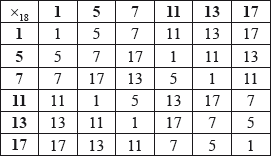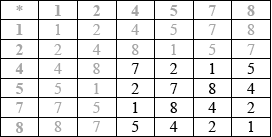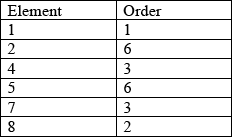Question
Consider the group \(\{ G,{\text{ }}{ \times _{18}}\} \) defined on the set \(\{ 1,{\text{ }}5,{\text{ }}7,{\text{ }}11,{\text{ }}13,{\text{ }}17\} \) where \({ \times _{18}}\) denotes multiplication modulo 18. The group \(\{ G,{\text{ }}{ \times _{18}}\} \) is shown in the following Cayley table.

The subgroup of \(\{ G,{\text{ }}{ \times _{18}}\} \) of order two is denoted by \(\{ K,{\text{ }}{ \times _{18}}\} \).
Find the order of elements 5, 7 and 17 in \(\{ G,{\text{ }}{ \times _{18}}\} \).
State whether or not \(\{ G,{\text{ }}{ \times _{18}}\} \) is cyclic, justifying your answer.
Write down the elements in set \(K\).
Find the left cosets of \(K\) in \(\{ G,{\text{ }}{ \times _{18}}\} \).
Answer/Explanation
Markscheme
considering powers of elements (M1)
5 has order 6 A1
7 has order 3 A1
17 has order 2 A1
[4 marks]
\(G\) is cyclic A1
because there is an element (are elements) of order 6 R1
Note: Accept “there is a generator”; allow A1R0.
[3 marks]
\(\{ 1,{\text{ }}17\} \) A1
[1 mark]
multiplying \(\{ 1,{\text{ }}17\} \) by each element of \(G\) (M1)
\(\{ 1,{\text{ }}17\} ,{\text{ }}\{ 5,{\text{ }}13\} ,{\text{ }}\{ 7,{\text{ }}11\} \) A1A1A1
[4 marks]
Examiners report
[N/A]
[N/A]
[N/A]
[N/A]
Question
The group \(\{ G,{\text{ }} * \} \) is defined on the set \(G\) with binary operation \( * \). \(H\) is a subset of \(G\) defined by \(H = \{ x:{\text{ }}x \in G,{\text{ }}a * x * {a^{ – 1}} = x{\text{ for all }}a \in G\} \). Prove that \(\{ H,{\text{ }} * \} \) is a subgroup of \(\{ G,{\text{ }} * \} \).
Answer/Explanation
Markscheme
associativity: This follows from associativity in \(\{ G,{\text{ }} * \} \) R1
the identity \(e \in H\) since \(a * e * {a^{ – 1}} = a * {a^{ – 1}} = e\) (for all \(a \in G\)) R1
Note: Condone the use of the commutativity of e if that is involved in an alternative simplification of the LHS.
closure: Let \(x,{\text{ }}y \in H\) so that \(a * x * {a^{ – 1}} = x\) and \(a * y * {a^{ – 1}} = y\) for all \(a \in G\) (M1)
multiplying, \(x * y = a * x * {a^{ – 1}} * a * y * {a^{ – 1}}\) (for all \(a \in G\)) A1
\( = a * x * y * {a^{ – 1}}\) A1
therefore \(x * y \in H\) (proving closure) R1
inverse: Let \(x \in H\) so that \(a * x * {a^{ – 1}} = x\) (for all \(a \in G\))
\({x^{ – 1}} = {(a * x * {a^{ – 1}})^{ – 1}}\) M1
\( = a * {x^{ – 1}} * {a^{ – 1}}\) A1
therefore \({x^{ – 1}} \in H\) R1
hence \(\{ H,{\text{ }} * \} \) is a subgroup of \(\{ G,{\text{ }} * \} \) AG
Note: Accuracy marks cannot be awarded if commutativity is assumed for general elements of \(G\).
[9 marks]
Examiners report
This is an abstract question, clearly defined on a subset. Far too many candidates almost immediately deduced, erroneously, that the full group was Abelian. Almost no marks were then available.
Question
The following Cayley table for the binary operation multiplication modulo 9, denoted by \( * \), is defined on the set \(S = \{ 1,{\text{ }}2,{\text{ }}4,{\text{ }}5,{\text{ }}7,{\text{ }}8\} \).
a.Copy and complete the table.[3]
b.Show that \(\{ S,{\text{ }} * \} \) is an Abelian group.[5]
c.Determine the orders of all the elements of \(\{ S,{\text{ }} * \} \).[3]
d.(i) Find the two proper subgroups of \(\{ S,{\text{ }} * \} \).
(ii) Find the coset of each of these subgroups with respect to the element 5.[4]
e.Solve the equation \(2 * x * 4 * x * 4 = 2\).[4]
▶️Answer/Explanation
Markscheme
 A3
A3
Note: Award A3 for correct table, A2 for one or two errors, A1 for three or four errors and A0 otherwise.
[3 marks]
the table contains only elements of \(S\), showing closure R1
the identity is 1 A1
every element has an inverse since 1 appears in every row and column, or a complete list of elements and their correct inverses A1
multiplication of numbers is associative A1
the four axioms are satisfied therefore \(\{ S,{\text{ }} * \} \) is a group
the group is Abelian because the table is symmetric (about the leading diagonal) A1
[5 marks]
 A3
A3
Note: Award A3 for all correct values, A2 for 5 correct, A1 for 4 correct and A0 otherwise.
[3 marks]
(i) the subgroups are \(\{ 1,{\text{ }}8\} \); \(\{ 1,{\text{ }}4,{\text{ }}7\} \) A1A1
(ii) the cosets are \(\{ 4,{\text{ }}5\} \); \(\{ 2,{\text{ }}5,{\text{ }}8\} \) A1A1
[4 marks]
METHOD 1
use of algebraic manipulations M1
and at least one result from the table, used correctly A1
\(x = 2\) A1
\(x = 7\) A1
METHOD 2
testing at least one value in the equation M1
obtain \(x = 2\) A1
obtain \(x = 7\) A1
explicit rejection of all other values A1
[4 marks]
Examiners report
The majority of candidates were able to complete the Cayley table correctly.
Generally well done. However, it is not good enough for a candidate to say something along the lines of ‘the operation is closed or that inverses exist by looking at the Cayley table’. A few candidates thought they only had to prove commutativity.
Often well done. A few candidates stated extra, and therefore incorrect subgroups.
[N/A]
The majority found only one solution, usually the obvious \(x = 2\), but sometimes only the less obvious \(x = 7\).
Question
A group \(\{ D,{\text{ }}{ \times _3}\} \) is defined so that \(D = \{ 1,{\text{ }}2\} \) and \({ \times _3}\) is multiplication modulo \(3\).
A function \(f:\mathbb{Z} \to D\) is defined as \(f:x \mapsto \left\{ {\begin{array}{*{20}{c}} {1,{\text{ }}x{\text{ is even}}} \\ {2,{\text{ }}x{\text{ is odd}}} \end{array}} \right.\).
a.Prove that the function \(f\) is a homomorphism from the group \(\{ \mathbb{Z},{\text{ }} + \} {\text{ to }}\{ D,{\text{ }}{ \times _3}\} \).[6]
b.Find the kernel of \(f\).[3]
c.Prove that \(\{ {\text{Ker}}(f),{\text{ }} + \} \) is a subgroup of \(\{ \mathbb{Z},{\text{ }} + \} \).[4]
▶️Answer/Explanation
Markscheme
consider the cases, \(a\) and \(b\) both even, one is even and one is odd and \(a\) and \(b\) are both odd (M1)
calculating \(f(a + b)\) and \(f(a){ \times _3}f(b)\) in at least one case M1
if \(a\) is even and \(b\) is even, then \(a + b\) is even
so\(\;\;\;f(a + b) = 1.\;\;\;f(a){ \times _3}f(b) = 1{ \times _3}1 = 1\) A1
so\(\;\;\;f(a + b) = f(a){ \times _3}f(b)\)
if one is even and the other is odd, then \(a + b\) is odd
so\(\;\;\;f(a + b) = 2.\;\;\;f(a){ \times _3}f(b) = 1{ \times _3}2 = 2\) A1
so\(\;\;\;f(a + b) = f(a){ \times _3}f(b)\)
if \(a\) is odd and \(b\) is odd, then \(a + b\) is even
so\(\;\;\;f(a + b) = 1.\;\;\;f(a){ \times _3}f(b) = 2{ \times _3}2 = 1\) A1
so\(\;\;\;f(a + b) = f(a){ \times _3}f(b)\)
as\(\;\;\;f(a + b) = f(a){ \times _3}f(b)\;\;\;\)in all cases, so\(\;\;\;f:\mathbb{Z} \to D\) is a homomorphism R1AG
[6 marks]
\(1\) is the identity of \(\{ D,{\text{ }}{ \times _3}\} \) (M1)(A1)
so\(\;\;\;{\text{Ker}}(f)\) is all even numbers A1
[3 marks]
METHOD 1
sum of any two even numbers is even so closure applies A1
associative as it is a subset of \(\{ \mathbb{Z},{\text{ }} + \} \) A1
identity is \(0\), which is in the kernel A1
the inverse of any even number is also even A1
METHOD 2
\({\text{ker}}(f) \ne \emptyset \)
\({b^{ – 1}} \in {\text{ker}}(f)\) for any \(b\)
\(a{b^{ – 1}} \in {\text{ker}}(f)\) for any \(a\) and \(b\)
Note: Allow a general proof that the Kernel is always a subgroup.
[4 marks]
Total [13 marks]
Examiners report
[N/A]
[N/A]
[N/A]
